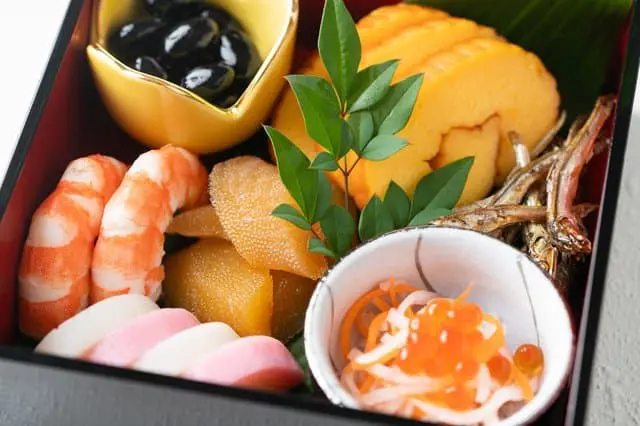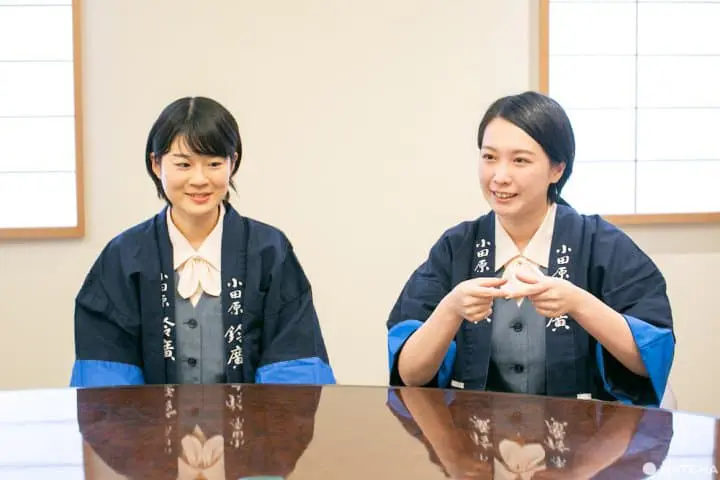The Mystery of Fish Cake Revealed! Interview With Suzuhiro Kamaboko

Everything you've wanted to know about kamaboko fish cake! We interviewed Suzuhiro Kamaboko to dive into the mysteries surrounding kamaboko. We also spoke with Vice-President Teisuke Suzuki, who introduced kanikama (imitation crabmeat known as surimi) to the United States.
Dive Into the Mysteries of Kamaboko!

Picture courtesy of Suzuhiro Kamaboko
Kamaboko is often seen as a mysterious food by international visitors in Japan. It's featured in osechi—traditional dishes served on New Year’s Day—and is a vital ingredient at the dinner table for Japanese households.
MATCHA’s international staff also had questions regarding kamaboko: What is it made from? Why is it pink? Why is it served on a board?

Our editorial team visited the Suzuhiro Kamaboko headquarters in Odawara to solve the mysteries hanging over kamaboko.
Table of Contents
- 1. The “Kamaboko Sisters” Answer Our Questions!
- 2. Question 1: What Is Kamaboko Made From?
- 3. Question 2: Do Kamaboko Artisans Really Exist?
- 4. Question 3: Why Is Kamaboko Pink or White?
- 5. Question 4: Why Is Kamaboko Eaten on New Year’s Day?
- 6. Question 5: What Is the Wooden Board Used For?
- 7. High Protein, Low Calories, and Easy to Eat
- 8. Known in the West: Where Does Surimi Come From?
- 9. The Vice-President Was Behind the Creation of Surimi!
- 10. A Hit Product! The Birth of "King Krab"
- 11. Making the World Healthy With Fish Protein!
- 12. Thinking About the Future of the Earth
- 13. Celebrate New Year's With Kamaboko!
Purchase Products From Suzuhiro Kamaboko’s Online Shop (Japanese)
The “Kamaboko Sisters” Answer Our Questions!

Left: Ms. Sakai; Right: Ms. Ohno
The PR managers of Suzuhiro Kamaboko, Ms. Sakai and Ms. Ohno, answered our burning questions. Known as the Kamaboko Sisters, these two are passionate about Suzuhiro’s delicious kamaboko.
In other words, they’re kamaboko specialists! Let’s not waste any time and dive right into everyone's questions!
Question 1: What Is Kamaboko Made From?
Kamaboko has a fun springy texture that may surprise those who try it. Many have likened it to mochi (rice cakes) or a sponge. What exactly is it made from?
According to Ms. Sakai, “Kamaboko’s main ingredient is fish. Silver white croaker, Japanese gissu, and other such fish are often used as ingredients for kamaboko. In fact, a single cylinder of kamaboko will contain up to seven varieties of fish.”
Ms. Ohno added, “Suzuhiro’s kamaboko prioritizes natural ingredients so the lack of chemical additives and preservatives is a main feature!”
Question 2: Do Kamaboko Artisans Really Exist?

MATCHA’s staff was surprised to learn that Suzuhiro's kamaboko is made by hand. Do such artisans really exist?
Ms. Sakai replied, “That’s correct. The artisans who make kamaboko have earned a national certification as Fish Paste Product Manufacturing Technicians."
She continued, "In fact, there are five steps to making kamaboko: filleting the fish for meat, rinsing it in water, grinding it into a paste, shaping it onto wooden boards, and steaming it. The product is made while inspecting the condition of the fish and regulating its moisture level. Therefore, an artisan’s experience and intuition play a huge part in its overall flavor."
Ms. Ohno added, “The artisan’s high level of expertise is what helps create a more supple, springy texture.”
Suzuhiro values the delicious flavors that can only be created by human hands.
Question 3: Why is Kamaboko Pink or White?

Our staff also wanted to know why kamaboko appears either pink or white? What’s the reasoning behind these colors?
According to Ms. Sakai, “The pink and white symbolize 'kohaku' (red-and-white) in Japan, which is an auspicious color combination. Red signifies fortune while white symbolizes purity.”
Ms. Ohno added, “The two colors are traditionally placed with red to the right and white to the left. As such, the proper way to arrange pink-colored kamaboko is placing it to the right.”
In Japan, it's customary to hang red and white curtains during festive occasions. It's interesting to learn that there’s a proper meaning behind kamaboko’s colors!
Question 4: Why Is Kamaboko Eaten on New Year’s Day?

Photo by Pixta
Kamaboko is a staple osechi dish eaten during the New Year’s holiday in Japan. But why is it so important for welcoming in the new year?
Ms. Sakai explained, “It's a long-standing Japanese tradition to select auspicious dishes for festive and celebratory occasions. This is also the case with red and white colors. Kamaboko’s half-moon shape resembles the sun rising from the horizon and is considered to bring good luck.”
Ms. Ohno added, “Kamaboko requires time and effort since it's made with several varieties of fish. So, it was considered a special dish for people who lived centuries ago. There are even records of kamaboko being served at banquets during the Heian Period.”
Question 5: What Is the Wooden Board Used For?

Kamaboko is always packaged with a wooden board. However, many international visitors may find this packaging unsual.
Ms. Sakai replied, “The kamaboko board acts as the base for the fish paste to be arranged. There is a reason why this wooden board is used."
She continued, "Wood helps regulate moisture in the air by absorbing and expelling water to maintain a proper level of moisture. When kamaboko is steamed, this board controls the moisture, so it stays at a moderate level.”
Ms. Ohno further explained, “The wooden board also prevents the kamaboko from drying inside your refrigerator, and acts as a natural preservative.”
Moreover, the boards are made from Japanese fir trees, which won’t curve or break during the steaming process.
After you've finished eating the kamaboko, a fun craft project would be painting your wooden board; at the Suzuhiro Kamaboko Museum, kamaboko boards featuring various illustrations are on display.
High Protein, Low Calories, and Easy to Eat

What message does Suzuhiro Kamaboko want to share with our readers in Japan and overseas?
Ms. Ohno replied, “Kamaboko is known for having a delicious flavor that people won’t grow tired of. But that’s not all. Thanks to the generous amount of fish used, it's high in protein and low in calories. Kamaboko is really healthy."
She continued, "I hope readers will not only eat kamaboko during festive occasions, but also introduce the product into their daily lives.”

Umiyama Hors d’oeuvre
Ms. Sakai continued, “Suzuhiro Kamaboko has over 200 products. Fan favorites include the bite-sized Puchi Kama or the terrine-like Umiyama Hors d’oeuvre!”
Are you interested in purchasing these products? Then check out Suzuhiro’s online shop! You'll also find a vast lineup of kamaboko at Suzuhiro Kamaboko Village, their flagship location. It’s great for those looking for souvenirs, too!
Purchase Products From Suzuhiro Kamaboko’s Online Shop (Japanese)
Known in the West: Where Does Surimi Come From?

Photo by Pixta
During our interview with the Kamaboko Sisters, we learned that fish paste is the main ingredient for kamaboko. But here's another question! In the United States and Europe, surimi refers to kanikama (imitation crab).
Is the surimi sold overseas different from the kanikama products in Japan?
The Vice-President Was Behind the Creation of Surimi!

Teisuke Suzuki, the Vice-President of Suzuhiro Kamaboko, told us about their most internationally acclaimed product: surimi (or "kanikama" in Japanese).
“Kanikama is a type of kamaboko made to imitate the appearance and flavor of crab. I wanted to challenge myself and be the first person to sell it in the states.”
In 1978, Vice-President Suzuki traveled to the U.S. on a special assignment from the then-president. However, his objective wasn’t to sell kanikama, but rather, to research fish.
“At the time, seafood in America was heavily centered around shrimp and crab. Fish caught in trawl nets while shrimping were discarded. We intented to use those fish as ingredients for kamaboko.”

Picture courtesy of Suzuhiro Kamaboko
There's a scene in the film “Forrest Gump” where the protagonist becomes hugely successful in shrimping. We learned that Vice-President Suzuki visited a harbor in Alabama during his assignment in America, which later became a filming location for the hit movie.
“I was ultimately unable to obtain the fish, and the research was abandoned. My next challenge was to sell kanikama. I had huge dreams and aimed to conquer all of America with kanikama.”
Listening to Vice-President Suzuki’s story feels watching a movie unfold!
A Hit Product! The Birth of "King Krab"

Vice-President Suzuki opened a kanikama production factory in 1981. This coincided with an increase in health trends in the US.
“Crab was always popular in the US. So, I thought there would be a demand for kanikama, which is high in fish protein and low in calories.”
Careful consideration went into the flavor. They emphasized creating the taste of crab to suit North Americans, who prefer potent flavors.

Picture courtesy of Suzuhiro Kamaboko
“We intentionally didn’t market the product as Japanese food. Naming it 'King Krab' was another method for Americans to accept this new seafood product."
The vice-president laughed when revealing there were zero orders at first.
However, the product gradually garnered attention among the public from local supermarkets and restaurants. In just a few years, it became such a huge hit that they could no longer keep up with incoming orders and production!
Making the World Healthy With Fish Protein!

Picture courtesy of Suzuhiro Kamaboko
Currently, King Krab is no longer available in stores. However, kanikama is universally known by the name "surimi."
How does Vice-President Suzuki feel about the surimi culture overseas?
“There are many other delicious fish paste products besides kanikama. Fish protein is low-fat and easily digested. I want people overseas to continue enjoying all varieties of fish paste products, such as kamaboko and chikuwa."
He added, "In America, kanikama has even become a popular ingredient in sushi and tortillas. I feel that these innovative ideas are necessary to sustain the future of surimi culture.”
Suzuhiro Kamaboko’s motto is “become a long-established company without acting established.” This powerful message conveys the importance of preserving tradition while continuously trying new things.
Thinking About the Future of the Earth

Currently, Suzuhiro Kamaboko is proactive in environmental issues and the utilization of natural energy.
“Kamaboko is made from the bounty of the ocean (fish), forest (water), and village (people and culture). Climate change and the decline in fishing resources are major problems. We must consider the effects on our natural environment to continue making delicious kamaboko for the future.”
Moreover, they are raising awareness of environmental issues precisely because they’re a kamaboko brand.
The kamaboko we’ve been eating this whole time was filled with the blessings of nature, artisanal skill, and environmental consideration!
Celebrate New Year's With Kamaboko!

Kamaboko Pinchos
It's common for Japanese people to eat kamaboko with soy sauce. However, we’ve heard it pairs deliciously with olive oil or served on a skewer with bacon and green perilla.
With the new year fast approaching, why not celebrate with a side dish of kamaboko to bring in good luck?
Purchase Products From Suzuhiro Kamaboko’s Online Shop (Japanese)
Read also
Written by Kumiko Ishigaki
Photos by Chiaki Ono
Sponsored by Suzuhiro Kamaboko
MATCHA's promotional account for corporate and local government advertising. We aim to provide useful information to our readers in an enjoyable manner.







































![[2026] Top 5 Strawberry Picking Spots in Tokushima, Naruto| Farms and Access Guide for January to May](https://resources.matcha-jp.com/resize/720x2000/2025/03/06-227165.webp)

